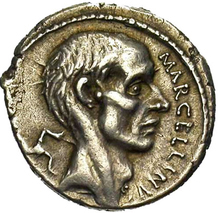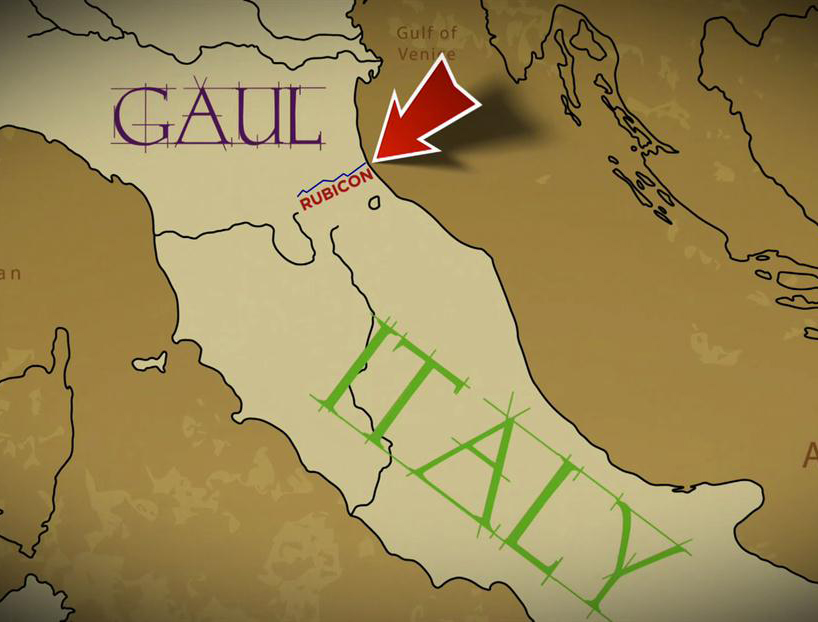He was called the “Sword of Rome” in his time, but a man forgotten in popular history. He should rank among the greatest military leaders that Italy produced, up there with Julius Caesar, Napoleon, and Garibaldi. Marcus Claudius Marcellus created the Italy we know today.

on his left.
On March 1st, 222 B.C. he was given a triumph by the Roman Senate for extending Italy to the Alps. He had to crush an occupying Celtic army to do so, and personally killed their king on the battlefield. He was 46-years-old at the time. But that wasn’t the pinnacle of his career. He later beat Hannibal in battle when Roman fortunes were at their lowest and the Italic people needed a morale boost. Soon after, he subdued the rebellious Sicilian city of Syracuse keeping that island out of Hannibal’s hands.
The pictured coin was produced by the Roman mint after his death. It shows a balding, sinewy man with a prominent nose. Modern Italians are more blessed than any other people in having such precise details of our tri-millennial history. Jews don’t know what Moses or David looked like. The Chinese don’t have realistic portraits of their emperors or wise men. But we have mountains of written evidence of our forebears and 3-D images of them as well.
To understand what Marcellus accomplished look at the map of ancient Italy below. Italia only extended as far north as the Rubicon River. North of that was Gallia Cisalpina or “Gaul this side of the Alps” – it contained the lush Po valley and eight future Italian regions. It was called Gaul because Celtic tribes invaded around 390 B.C. and drove out Etruscan settlements. Conflict between these Celts and the Romans came to a head in 225 BC when Roman generals began rolling up victories. By early 222 B.C. Marcellus met the Celts at Clastidium, 40 miles west of Milan. It was there that the Celtic king challenged him to a one-on-one. The two jousted on horseback and Marcellus speared the king off his horse, dispatching him in the dust.

With their leader dead, the Celts retreated to Milan (Mediolanum) where Marcellus and his co-consul forced their surrender. Northern Italy was now Roman, and two settlements were raised on either side of the Po River to defend the new territory: Cremona and Piacenza. It was still called Gallia Cisalpina when Julius Caesar later recruited Italian colonists there to conquer Gaul “across the Alps” (France). And when Caesar decided to challenge his political enemies in Rome in 49 B.C., he crossed the Rubicon to “invade” Italia. It wasn’t until Augustus (31 B.C. – 14 A.D.) that the territory was incorporated into Italia.
No sooner had Marcellus conquered this territory then Hannibal invaded it (218 B.C.) and swept down the peninsula. He crushed every Roman/Italian legion sent to stop him. The bloodbath culminated in the infamous battle of Cannae in the southern region of Puglia where thousands of Italic legionaries perished or deserted. At this darkest hour, Marcellus later reappeared and surprised elements of Hannibal’s army killing some 3,000 – the first Roman victory.
To punish the Italian city of Capua (in Campania), which had helped Hannibal, Marcellus unleashed his troops to slaughter and enslave some of the population as a warning to other wavering Italian cities. Roman Italy was fighting for its life.
The Senate then dispatched Marcellus to Syracuse, Sicily which had just gone over to Hannibal. Marcellus’s reputation preceded him as the city fathers pleaded for negotiations. Marcellus would have none of it and stormed the city walls. It was during this siege that the mathematician Archimedes was killed by a Roman soldier, contrary to Marcellus’s orders.
It was at Syracuse that Marcellus had an epiphany. Awestruck by the wonders of Sicilian-Greek art, Marcellus spared the city the fate of Capua. Instead, he plundered statuary and artwork to adorn a new temple being built in Rome. In effect, Marcellus hooked the Romans on Greek art, and they never looked back.
Our hero’s story ends with his death during an enemy ambush on Italian soil. Marcellus went down fighting well into his 60s. Italians keep his legacy alive as a first name, Marcello. -JLM




Recent Comments